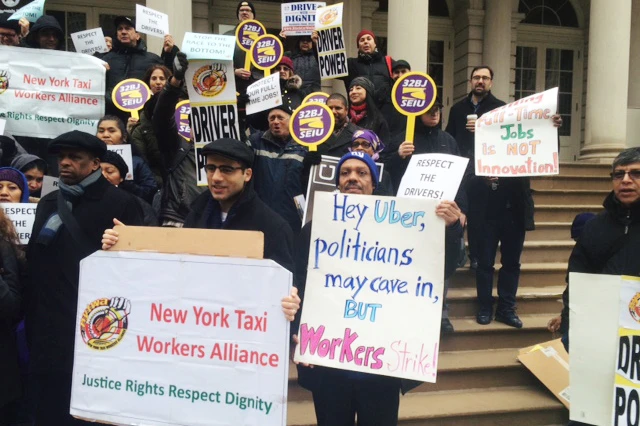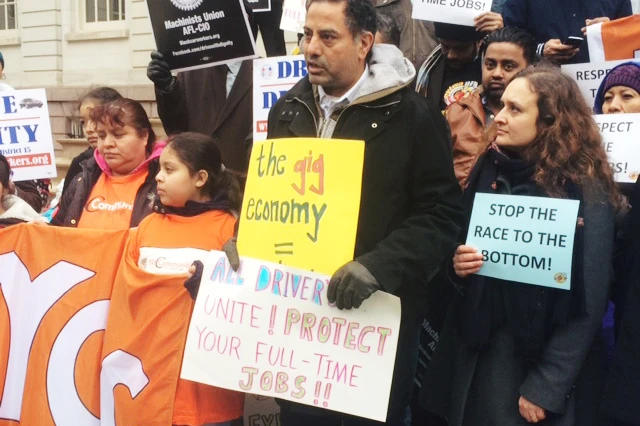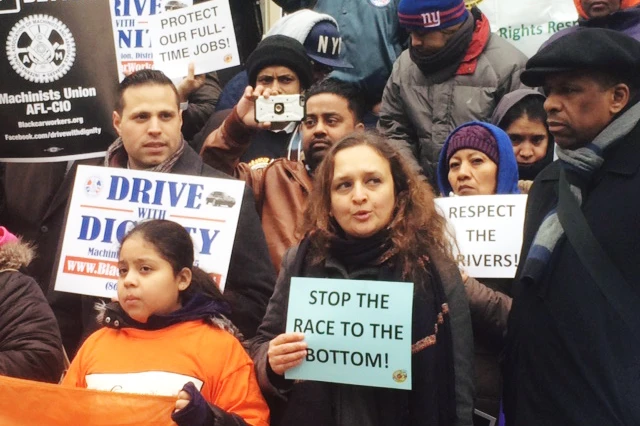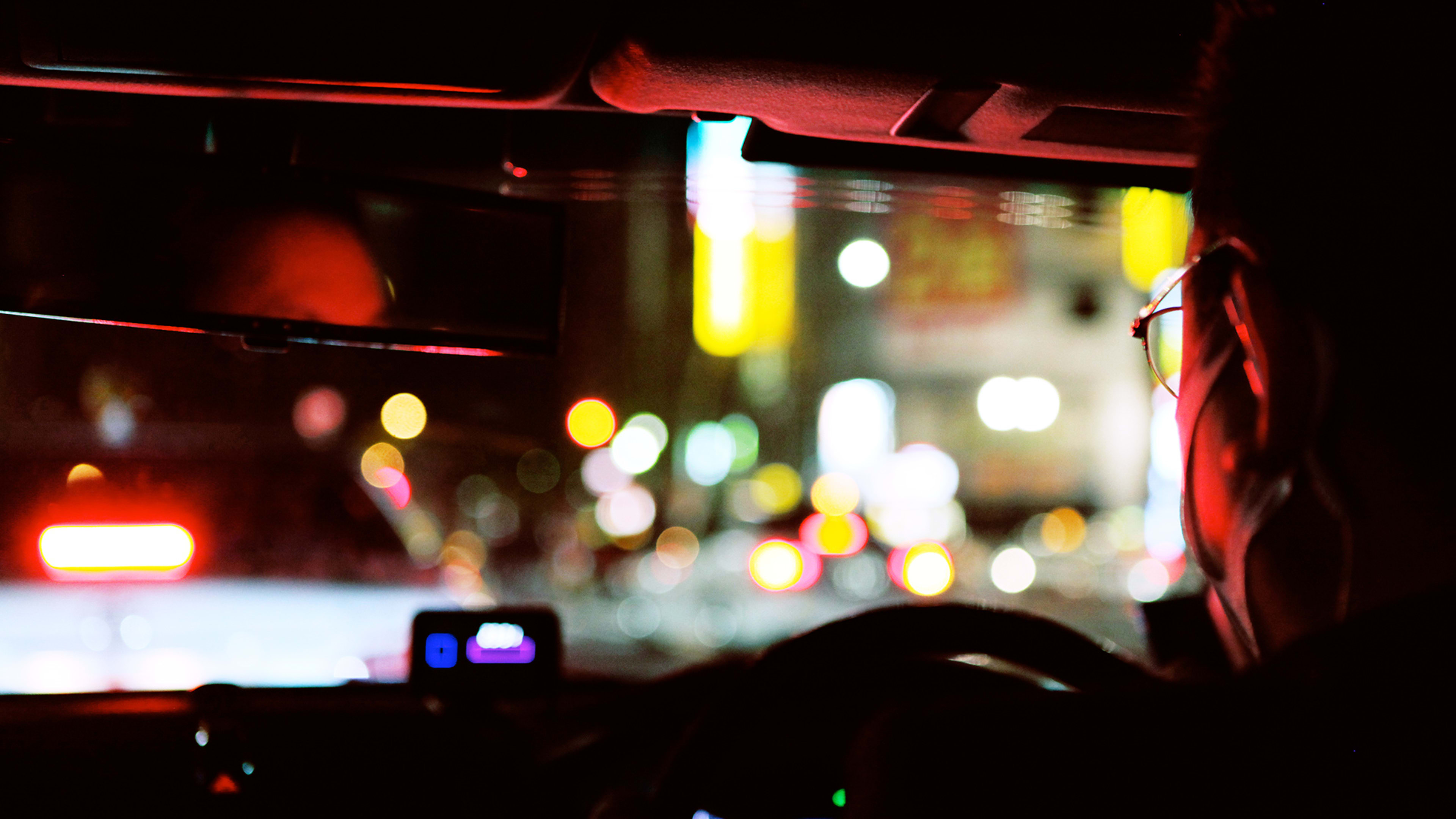Last year, taxi drivers in Belgium threw eggs at Uber drivers’ cars and blocked them from picking up passengers during a protest against the ride-hailing company. In France, during another day of protests, taxi drivers attacked Uber drivers, in a couple of cases even setting their cars on fire. Footage from a protest against Uber in Toronto shows a man banging on the window of someone he suspects is driving for Uber, only to be dragged 20 feet before letting go. And in cities across the U.S., Uber drivers and taxi drivers have faced off on opposite sides of protests over Uber regulations.
Both Uber and taxi trade associations have historically made efforts to fuel this vitriol. “We’re in a political campaign, and the candidate is Uber and the opponent is an asshole named Taxi,” Uber CEO Travis Kalanick noted while explaining the rift in 2014. “Nobody likes him, he’s not a nice character, but he’s so woven into the political machinery and fabric that a lot of people owe him favors.” The Taxicab, Limousine and Paratransit Association has poured money into a smear campaign against Uber that includes, for instance, a running tally of alleged kidnappings and sexual assaults by Uber drivers.
But as Uber and Lyft cut fares, some of their drivers are beginning to see taxi drivers not as opponents, but as allies in a labor battle that impacts both groups.”When I first started driving, taxis hated Uber drivers, and Uber drivers hated taxis,” says Abe Husein, a former Uber driver who has helped organize strikes and protests in Kansas City and nationwide. “Now everybody hates Uber. Times have changed.”

On Wednesday, the New York Taxi Workers Alliance (NYTWA) and the International Association of Machinists, which represents black car drivers, cohosted a protest at New York’s City Hall to call for Uber and Lyft to reinstate fare rates that they cut by 15% last month. The NYTWA has organized several similar protests throughout the last several weeks, and another local chapter of the Taxi Workers Alliance has organized more in Philadelphia. “They were more pro-taxi,” says Abdoul Diallo, an Uber driver organizer in New York City, about the NYTWA. “But what they realized is that Uber drivers were also really taxi drivers. It’s just a new form of doing it. Their members were leaving the livery cab industry and going to work for Uber, so it became important for them to stand up, not just in the taxi industry, but for workers in general.”
At the demonstration in New York on Wednesday, a group of about 40 people stood on the steps of City Hall holding signs with slogans like, “Killing jobs is not innovation,” and, “Hey Uber, politicians may cave in, but workers strike.” Bhairavi Desai, the president of the National Taxi Workers Alliance, which represents 19,000 drivers in New York, led a short press conference. “We are here to say to Uber and Lyft, to all of these app-based dispatch companies, the race to the bottom must end,” began Desai, who had no microphone and had to shout to be heard. “We will not let them continue to gut our incomes. When the biggest dispatching company in New York City, with over 30,000 affiliated vehicles, starts to cut its rates, it sends a signal across the industry to cut the rates across the board.” Though Uber says it is a technology company, Desai believes it is no different than any car dispatcher.

The fates of Uber drivers and taxi cab drivers are intertwined. As Uber lowers fares, its drivers make less money on each mile they drive, but Uber also becomes more compelling to budget-conscious customers as an alternative to taxis. And while the number of taxis in New York is limited by the medallion system, the number of Uber drivers is not. Last year, when Mayor Bill de Blasio proposed legislation that, if passed, would have capped the number of Uber drivers, Uber lobbied against him—going so far as to install a “DeBlasio’s Uber” feature in its app that showed New York City residents long wait times. De Blasio dropped the initiative days later.
In many ways, the beginning of the taxi alliance was not unlike today’s scattershot of strikes and protests organized by Uber drivers. Desai cofounded the Taxi Workers Association in 1998, after she initiated a strike among taxi drivers in response to new rules imposed by Mayor Rudolph Giuliani. Like Uber drivers, most taxi drivers have been classified as independent contractors, which means they do not fall under the law that protects collective action among employees. Nonetheless, in 2011, the National Taxi Workers Alliance became the first association of independent contractors to be chartered by the AFL-CIO.

While taxi drivers and Uber drivers have somewhat aligned interests, though, the effort to unionize them isn’t solely out of a sense of brotherhood. Union members pay dues: More members means more resources. Heartened by a bill passed in Seattle last year that gave workers for Uber, Lyft, and other app dispatch services the right to unionize, many unions have been working to represent Uber drivers. Earlier this month, the International Brotherhood of Electrical Workers, Local 1430, formally requested to represent Uber drivers who make pickups at LaGuardia Airport (drivers would need to be made employees or prompt a change in the law first). Another group of Uber drivers is working with the Amalgamated Transit Union.
“No matter what you’re driving, it’s one battle,” says Diallo. “Uber is not affecting Uber drivers, per se, they are affecting the industry.”
At the protest, Desai echoed his sentiment.
“Much has been said about the division between taxi drivers and Uber drivers,” she said. “But I want to say to you, as the head of the New York Taxi Workers Alliance, from our friends the machinists, as the two organizations that have been fighting for the rights of taxi drivers and black car drivers for close to 20 years, that for drivers, there is no division. We know we will win only if we are united as a workforce. Because divided we beg, but united we win.”
Update: An Uber spokesperson provided this statement: “Drivers control where and when they work, and they are free to use other apps at the same time as they’re on Uber. It’s why tens of thousands of New Yorkers have partnered with us over the last four years. Of course there’s always more we can do — and we are always happy to talk with drivers about what they’d like to see next.”
Recognize your brand’s excellence by applying to this year’s Brands That Matter Awards before the early-rate deadline, May 3.
